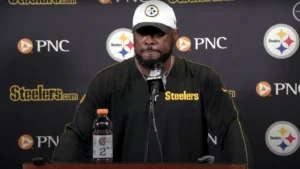

**Tomlin Reveals the Strategy Behind Pulling Russell Wilson After Initial Drive**
In a surprising move that left fans and analysts buzzing, Pittsburgh Steelers head coach Mike Tomlin chose to pull quarterback Russell Wilson after just one drive in their latest game. The decision, which seemed abrupt to many, has been clarified by Tomlin, who provided insights into the strategic thinking behind it.
During the post-game press conference, Tomlin explained that the move was a calculated decision aimed at assessing the team’s readiness and adjusting their game plan. “We wanted to test different looks and see how our offensive line and receivers would respond under pressure,” Tomlin said. “Pulling Russell was part of a broader strategy to evaluate our depth and versatility in real-game scenarios.”
Tomlin emphasized that the decision was not a reflection of Wilson’s performance or a critique of his play. Instead, it was about creating a dynamic environment to better understand the team’s overall capabilities. “We have to be prepared for various scenarios,” Tomlin noted. “By rotating quarterbacks and giving other players a chance, we gather valuable information that can be critical as the season progresses.”
The early substitution allowed backup quarterbacks to gain crucial game experience and demonstrated Tomlin’s commitment to ensuring that all team members are game-ready. Tomlin also highlighted that this approach aligns with his long-term vision for building a resilient and adaptable team.
Critics of the move suggest it could disrupt team chemistry or signal underlying issues, but Tomlin remains steadfast in his approach. “Our goal is to maximize performance and ensure that we are prepared for any challenge that comes our way,” he said. “This is part of a larger plan to keep the team sharp and focused.”
As the season unfolds, the impact of this strategic decision will become clearer. For now, Steelers fans and analysts alike are left to ponder the implications of Tomlin’s unconventional move and its potential effects on the team’s future performance.



Be the first to comment